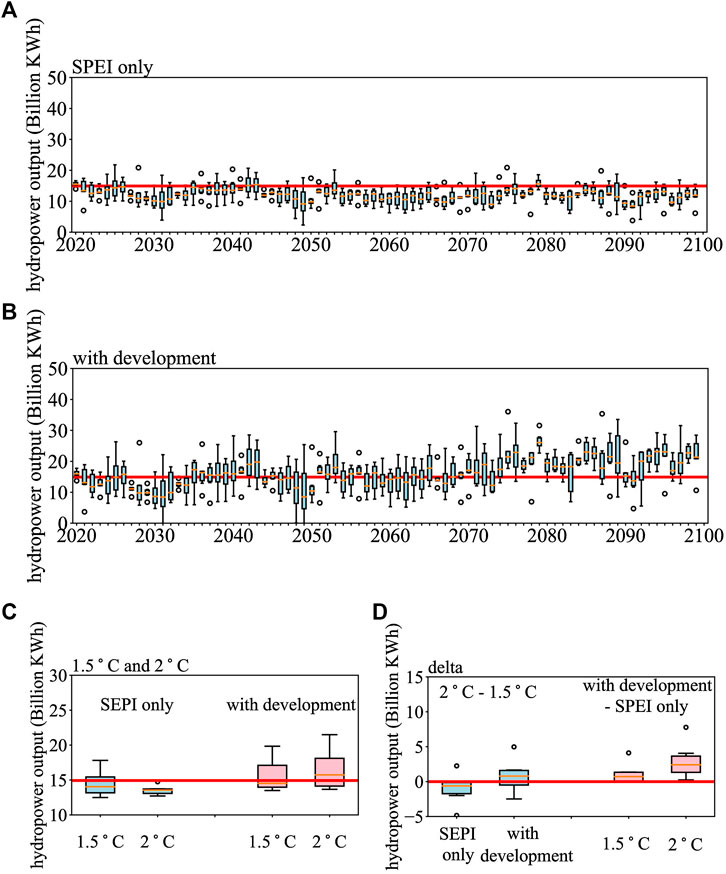- 1Collaborative Innovation Center on Forecast and Evaluation of Meteorological Disasters/Key Laboratory of Meteorological Disasters, Ministry of Education/Joint International Research Laboratory of Climate and Environment Change, Nanjing University of Information Science and Technology, Nanjing, China
- 2College of Atmospheric Science, Nanjing University of Information Science and Technology, Nanjing, China
- 3Nansen Zhu International Research Centre, Institute of Atmospheric Physics, Chinese Academy of Sciences, Beijing, China
- 4School of Applied Meteorology, Nanjing University of Information Science and Technology, Nanjing, China
A Corrigendum on
Drought Impacts on Hydropower Capacity Over the Yangtze River Basin and Their Future Projections Under 1.5/2 °C Warming Scenarios
by Wang, Y., Li, H., Sun, B., Chen, H., Li, H., and Luo, Y. (2020). Front. Earth Sci. 8:578132 doi: 10.3389/feart.2020.578132
In the original article, there is a mistake in Figure 10 as published. The figure was an old version mistakenly submitted by the authors. The corrected figure appears below.

FIGURE 10. Projections of hydropower capacity in Zhejiang Province during 2020–2100 under RCP4.5 when (A) considering only the meteorological condition and (B) considering the joint effects of the meteorological condition and the development of the hydropower station. (C) Projections of hydropower capacity in Zhejiang Province under the 1.5 and 2 °C warming target when only the meteorological conditions are considered (blue) and considering the joint effects of the meteorological condition and the development of the hydropower station (pink). (D) Differences between the 2 and 1.5 °C warming target (blue) and the effects of considering the development of hydropower stations (pink). The red lines indicate the historical mean (1999–2018) of hydropower capacity in Zhejiang Province in (A–C) and indicate the zero lines in (D). Open circles indicate abnormal data, color rectangles denote the spread of the 25th and the 75th quartiles, and the short orange line represents the median condition.
The authors apologize for this error and state that this does not change the scientific conclusions of the article in any way. The original article has been updated.
Keywords: drought, hydropower capacity, Yangtze River Basin, 1.5/2 °C warming scenarios, interannual increment
Citation: Wang Y, Li H, Sun B, Chen H, Li H and Luo Y (2021) Corrigendum: Drought Impacts on Hydropower Capacity Over the Yangtze River Basin and Their Future Projections Under 1.5/2°C Warming Scenarios. Front. Earth Sci. 8:615438. doi: 10.3389/feart.2020.615438
Received: 09 October 2020; Accepted: 28 October 2020;
Published: 14 January 2021.
Edited and reviewed by:
Bin Yu, Government of Canada, CanadaCopyright © 2021 Wang, Li, Sun, Chen, Li and Luo. This is an open-access article distributed under the terms of the Creative Commons Attribution License (CC BY). The use, distribution or reproduction in other forums is permitted, provided the original author(s) and the copyright owner(s) are credited and that the original publication in this journal is cited, in accordance with accepted academic practice. No use, distribution or reproduction is permitted which does not comply with these terms.
*Correspondence: Huixin Li, bGlodWl4aW5AbnVpc3QuZWR1LmNu; Bo Sun, c3VuYkBudWlzdC5lZHUuY24=
 Yu Wang
Yu Wang Huixin Li
Huixin Li Bo Sun1,2*
Bo Sun1,2* Yinxue Luo
Yinxue Luo